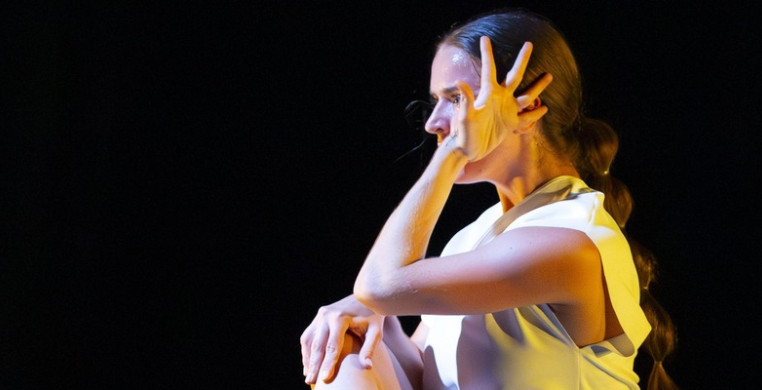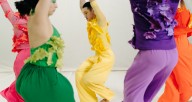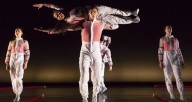In “Cycles,” dance becomes a celebration of life's continual rhythms and a testament to the beauty found in transformation. The Seldoms and Hedwig Dances presented four works on this theme at the Ruth Page Center for the Arts, July 12-13. The caliber of dance presented by both companies through innovative choreography, exceptional technical skill and creative world-building raises the standard of artistic excellence in the Chicago dance community. “Cycles” not only enriches the cultural fabric of the city but also sets a new benchmark for artistic achievement and aspiration.
As the audience enters the theater, they are immediately drawn to the striking stage display: curtains tied up to reveal the backstage, and a clutter of household and unconventional items around the space like extension cords, a chair on its side, bright yellow papers, a collapsible music stand and a 3D printed bodice outline. The dancers—Adeline Else, Jeff Hancock and Rigo Saura—enter the space, rearranging these objects.
"between," choreographed and directed by Ginger Farley, begins with a thunderous crash that prompts Hancock to convulse as if electrocuted by the chair. A sparse musical score features splashing water; the warm tones of a wood instrument and radio scans transport the audience into a world both familiar and surreal. Else enters the spotlight center stage, flowing organically and engaging in a serene body dialogue with outstretched limbs. Their presence is gentle yet commanding, effortlessly captivating the stage with confidence. Each movement flows gracefully—from the center of their torso through the outreach of their armco—conveying profound emotion through subtle nuances that invite the audience on a journey of introspection.
Else takes the front stage, quietly seated amidst woven plastic tendrils. Hancock and Saura embark on a movement journey slicing through space with sharp and precise gestures. The intense impact and abrupt stops and starts create electrifying tension and release. Dancing in proximity to each other yet disconnected, they navigate a piece imbued with apprehension, conveying emotions through physicality but struggling to connect. As they finally touch, visible discord manifests in violent shakes until they break contact.
 “between," with Adeline Else, Jeff Hancock and Rigo Saura; Photo by William Frederking
“between," with Adeline Else, Jeff Hancock and Rigo Saura; Photo by William Frederking
"between" offers a departure from traditional storytelling with its abstract and nuanced approach by not spoon-feeding the audience.The choreography, devoid of anecdotal gestures and unison movements, relies instead on subtlety and abstraction, and it encourages viewers to actively interpret the performance. The dancers' minimal interaction underscores the spatial dynamics of the stage, presenting tableauX open to multiple interpretations. This deliberate ambiguity sparks curiosity and invites contemplation, fostering a collaborative experience where audience members decode the piece's deeper meaning through movement and expression.
“All at Once” is an exploration into the artistic idea of Cubism, danced by Haley Marcin and choreographed by artistic director of The Seldoms, Carrie Hanson, drawing specifically from Pablo Picasso's 1907 painting, “Les Demoiselles d'Avignon.” With each angular movement and fragmented pose, Marcin explores the interplay of form and perspective, echoing the geometric shapes and multifaceted viewpoints characteristic of cubism.
The choreography unfolds as a living canvas, with limbs extending in sharp, disjointed angles that evoke Picasso's fractured planes and overlapping dimensions. Marcin's movements transform her body into a dynamic sculpture that adapts to unseen forces in space. The music by Tim Daisy enhances the abstract narrative through a fusion of rhythms and dissonances. Through "All at Once," Marcin and Hanson honor Picasso's vision while challenging the audience to rethink the boundaries of perception and interpretation in art and movement.
 “KUBA," with Rigo Saura; Photo by William Frederking
“KUBA," with Rigo Saura; Photo by William Frederking
"ciclos," choreographed by Gabriela Chavez in collaboration with dancers Damon D. Green and Haley Marcin, embarks on a poignant journey through grief, using dance to navigate its intricate emotional landscape. Huddled together in a spotlight, sparse piano notes prompt them to move, their choreography evolving into a powerful modern dance pas de deux.
Each movement speaks to their shared experience. Tender embraces and moments of separation reflect the ebb and flow of sorrow and resilience. Together, they navigate despair with vulnerability, finding solace and hope in each other's presence. Their journey through acceptance and renewal tells a powerful story of strength and interconnectedness that illustrates the intertwined emotions of love and loss.
The final piece, "KUBA," is a solo by Rigo Saura that explores his Cuban heritage through a fusion of tradition and innovation. Saura blends improvisational vulnerability with rhythmic repetition from Afro-Cuban traditions and contemporary dance, undulating his spine and stomping his feet in time to create a mesmerizing exploration. Incorporating mid-century Cuban video footage, the piece offers insight into Saura's historical examination. His improvisation is infused with spontaneity and emotional depths of longing that resonates with Cuban music's pulsating rhythms.
Costumed in a gown-like paper skirt with a bare torso, he undulates his spine, his hips "whining" while the skirt rustles like a musical score. Each movement blends his roots with internalized identity and history. In "KUBA," Saura invites the audience on a transcendent journey where cultural richness meets contemporary dance, bridging past and present. Saura's expression during bows revealed not just artistry but a poignant personal exploration.



